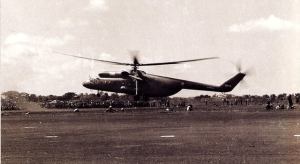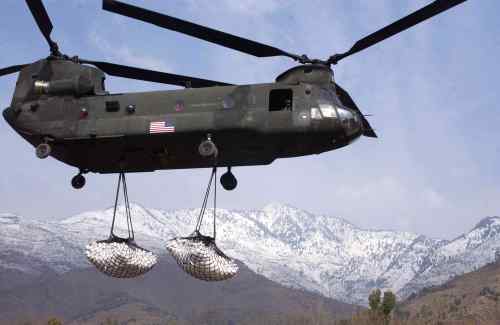My eyes stuck on an old photo in Dirgantara Museum, Yogyakarta. It was from early 1960, depicting Indonesian Air Force activities during Operation Dwikora in Kalimantan. That was the time when Indonesia launched confrontation — politically and militarily– against the born of Malaysia as an independent state by British colonial which territories include Sabah and Serawak in north Borneo, once belongs to Sulu kingdom of southern Philippine.
Indonesian Armed Forces or Tentara Nasional Indonesia (TNI) launch infiltration operations along north Borneo border against combine task force of British and Australian army. It was not the historical background that draw my attention. I saw a picture of big helicopter resemble AURI (old name of Indonesian Air Force nowadays bears name TNI AU). It was a giant Sovyet Mil Mi-6 Hook, the biggest rotary wing aircraft those days even compared to double rotor American CH-47 Chinook.
Wow, we once a big copper operator. Mi-6 Hook has five rotor blade span 35 meter in diameter with total weight more than 27 ton. But Mi-6 performace was not as good as Sovyet always advertise to foreign buyer, I mean in socialist way. With maximum take off weight of 42 ton, you can only spare 15 ton of payload including fuel and five crews. In theory, Hook can lift up to 10 tones cargo. But practically, this monstrous copper only able to lift 5 tones cargo because it needs so much fuel, up to 10 k liters to fly for only 2.5 hours.

Despite its monstrous size, the ill performer Mil Mi-6 Hook was not considered as a threat by neighbouring countries. AURI acquire 6 to 9 Hooks but only serve for five years until 1968. To shame, all AURI's Hooks was scrapped hence we cannot see them in the Dirgantara museum. credit: Indomiliter.wordpress.com
It far heavier than American heavy lift copper Sikorsky CH-53 Sea Stallion, Bell CH-47 Chinook or French Super Frelon. Its enormous size can only surpassed by its descendant, Mi-26 Helo which can lift up to 20 tones of cargo. But Mi-6 poor lift performance just below the American’s. Chinook can easily lift up to 12.5 tones of cargo.
After tsunami struck Aceh and took hundred thousands lives in late 2004, we saw a big humanitarian assistant mission conducted by armed forces and NGO from many friendly countries. Even it was not a military operation, United States (US) was not hesitate to deploy a big contingent of their armed forces including aircraft carrier and big hospital ship.
And yes, the US airborne team is not complete without their infamous Chinook helicopter, workhorse that served US for more than 40 years. With huge load capability, Chinook indeed very effective platform for delivering aid to remote mountainous areas.
Republic of Singapore Air Forces, Indonesian small neighbors, also deploy their Chinook in Aceh. Therefore, United Nations (UN) sent their old cheap but rugged and simple copper Mi-17. The Russian Mi-17 has less load capability by up to 4 tones of cargo, but it had been heavily fielded in every UN’s humanitarian operations around the globe.
TNI did their best with their relatively small numbers of helicopters. Indonesian Army (TNI AD) only has several squadron of old Bell 205, descendant of legendary Vietnam War veteran UH-1. TNI AU best equipment was Super Puma, license built by government firm PT Dirgantara Indonesia (PT DI) from Eurocopter.
Seeing Chinook and Mi-17’s actions in Aceh, it become obvious that Indonesia need a big aircraft with vertical and take off capability to deal with its inherit natural disaster. In more simple words, it desperately need big chopper.

Chinook can hoist up to 12.5 tones cargo internal and external. With better payload capability, Chinook was an ideal platform for a humanitarian mission. But only several western countries can afford to buy Chinook.
Indonesian government seems interested in Chinook to help Aceh and Nias Rehabilitation and Reconstruction Agency (BRR) duties, but Department of Defence (DoD) chose not to express their interest publicly due to current US military embargo on Indonesia that already being lift by Bush administration. It was not easy decision for TNI, especially TNI AU, to procure US made military stuff, after a decade long being crumpled by embargoes.
But Indonesian always find a way or another. DoD Secretary General, LetGen Sjafrie Sjamsoeddin, said Chinook procurement best implemented by BRR, with abundant fund given by donor countries, for its original role would be for Aceh reconstruction program. ”DoD doesn’t have enough money to acquire Chinook. If so, the budget process will took long time. It will be better for BRR to buy Chinooks and TNI will be the operator,” said Sjafrie around 2005.
It was a good idea. As a civilian body, BRR will not affected if US impose military embargo on Indonesia again. Despite US complex system on foreign military purchase, it differentiate between civilian and military version of the airplane bought by foreign country. A spare part of C-130 Hercules transport plane can be considered weapon if the buyer is military institution then become subject to any military embargo.
But this slick schemes never find a way to be accomplished. Indonesia didn’t acquire Chinook and Indonesian Army (TNI AD) opt for Russian Mi-17 instead. My personal guess, Chinook’s price and TNI’s policy to avoid any procurement from US were the main considerations.
But Mi-17 procurement was not anew, it just continuation of troubled TNI AD procurement program in fiscal year 2003 which brought some DoD military officer to court for corruption charge.
TNI AD bought six Mi-17 V5 using DoD export credit facility financed by French private bank, BNP Paribas. The six Mi-17 delivered in August 2008, the last chance, five years after its fiscal year. TNI AD still waiting 10 more, as part of $1 billion export credit facility provided by Russian government, to assemble a full squadron of heavy transport copper. But Russian bureaucratic system seems require big patience.

TNI AD's Mi-17 serve their first humatiarian mission transporting aids for earthquake victims at Lubuk Anau, Agam Residence, West Sumatra, in 9th October 2009. More than 60 countries operate Mi-17 as main transport helicopter. TNI AD will have a full squadron consisting of 16 Mi-17 V5, the backbone of Army Aviation. credit: Getty Image
Actually Indonesia didn’t need any credit facility just to acquire Mi-17. It is the cheapest transport copper among all civilized world. You only need $5 million to bring home one Mi-17, compare to $16 million of fully electronic control Super Puma from PT DI. Double the price and you get Mi-35, helicopter gunship descended from Mi-17 airframe.
Considering price and load capacity, Mi-17 is superb. It can hoist up to 4.5 tones of cargo internally and on external hard point. If need be, it can hold four pods of rocket launcher and you get a combo transport-gunship. Some version has ramp door, suitable for military operation.
Indeed Chinook can lift triple payload of Mi-17’s, but it cost you around $32 million a piece. With money for a Chinook, you get six Mi-17 hence you can lift double of Chinook’s payload. The only think left to consider maybe the maintenance cost of six Mi-17 rotors compared to just four in Chinook.
Until now, UN still one of the big Mi-17 operator. It carry food and medicine to every refugee camp. It is an air truck. ”Even it can carry a small truck onboard and landed everywhere,” said a TNI officer who once served with TNI’s Garuda Expeditionary Forces in Cambodia under UN peace keeping mission.
Mi-17 served in every conflict thus make it battle proven. Mi-17 will fly willingly regardless her country was proxy of western or eastern bloc during cold war. It has undoubted ability in harsh condition, from high humidity of tropical jungle to extremely hot desert and freeze Scandinavian terrain. Everything survive Russian hard life can endure any world challenge.
Mi-17 procurement, again was a real blow for PT DI. For years PT DI was a sole helicopter provider for TNI. PT DI built Super Puma for TNI AU and Puma for TNI AL. PT DI built smaller Bell-205 for TNI AD but the licence has been expired and not continued because it considered obsolete design. It’s ironic, TNI AD later opt to buy Sokol, a Poland optimized version of oldies Russian Mi-2.
Practically, Mi-17 and Super Puma are real contender with their relatively same load capability. But comparation between Mi-17 and Super Puma is not apple to apple. Super Puma western digital avionics and computerized handling are far superior than old Russian electro-mechanical system. ”Super Puma control is so easy. I don’t believe any pilot can crash on Puma,” said a senior TNI AU officer. A luxury that cost you triple than the more simple Mi-17.
CEO of PT DI, Budi Santosa, admitted Russian copper is cheaper but that didn’t make it better than its western counterpart. ”I ensure you will have issue on maintenance. Russian engine known for needing more frequent maintenance than western one. It cost you less when buy, but you will pay more on maintenance. It’s just simple option,” said Budi.
With huge numbers of Mi-17 in TNI arsenal, we can only hope it will ease any humanitarian relief mission around Indonesian archipelago ring of fire with enormous mountainous remote areas. This country needs more heavy transport copper squadron in service with military or civilian institution.




